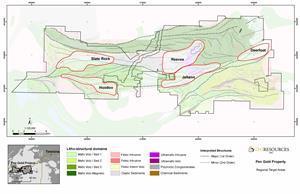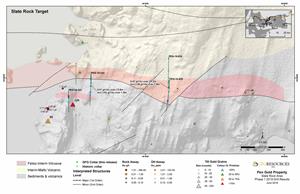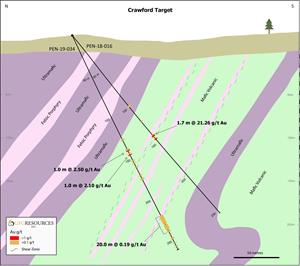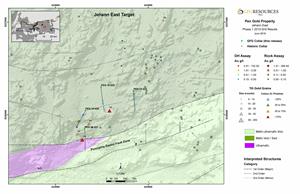GFG Hits Gold Mineralization at Slate Rock and Crawford Targets at the Pen Gold Project West of Timmins, ON
Highlights:
- Initial drilling at the Slate Rock target successfully outlined broad gold mineralization in hole PEN-19-025 grading 0.47 grams of gold per tonne (“g/t Au”) over 25.3 metres, including 3.58 g/t Au over 1.0 metre;
- Follow-up drilling at the recent Crawford discovery confirmed several distinct styles of gold mineralization down-dip of the discovery hole hosting up to 2.50 g/t Au over 1.0 metre and a new lower zone that graded 0.19 g/t Au over 20.3 metres;
- A comprehensive summer field program is well underway at the Pen Gold Project that includes regional till sampling, ground geophysics, prospecting and mapping;
- A Phase 2 drill program at the Pen Gold Project of approximately 3,500 metres is anticipated to begin late in the third quarter of 2019; and
- Drilling at the Rattlesnake Hills Gold Project in Wyoming is scheduled to begin in early July with joint venture partner Newcrest Mining Ltd.
SASKATOON, Saskatchewan, June 20, 2019 (GLOBE NEWSWIRE) -- GFG Resources Inc. (TSX-V: GFG) (OTCQB: GFGSF) (“GFG” or the “Company”) is pleased to announce assay results from the 2019 Phase 1 drill program at its 100% owned Pen Gold Project located 40 kilometres west of the prolific Timmins Gold District in Ontario, Canada. Results from the Phase 1 drill program successfully discovered gold mineralization at the Slate Rock target and follow-up drilling at the Crawford target returned several distinct styles of gold mineralization down-dip of the discovery hole which intersected 21.26 g/t Au over 1.7 metres (see link to news release: “GFG Discovers New Gold Zone with 21.26 g/t Gold over 1.7 Metres at Pen Gold Project West of Timmins, ON”).
The 2019 Phase 1 drill program consisted of 15 drill holes (4,400 m) ranging in depth from 150 to 350 metres (see Table 1). The program was designed to test six individual targets within the Slate Rock, Reeves and Jehann regional targets (see Figures 1-5). The six drill targets had no historic drilling and were generated from the Company’s 2018 systematic integration of geological, geochemical, structural and geophysical datasets. The Company also completed one follow-up drill hole at the recent Crawford discovery where it intersected 21.26 g/t Au over 1.7 metres, located in the Deerfoot regional target.
Brian Skanderbeg, President and CEO commented, “In our first year at the Pen Gold Project we have discovered multiple gold zones that reinforce our belief that this underexplored portion of the Abitibi has the potential to host significant gold systems. We view the results from Slate Rock and Crawford very positively as they demonstrate the gold systems are working and confirm efficacy of our targeting strategy. At the Jehann target, drilling did not explain the significant gold-in-till anomalies however, we remain confident in this target area and are currently conducting an in-fill till sampling program to vector in on the source of the gold. While the Reeves drill results demonstrated low gold values, we gained valuable insight on the regional geology of this untested 4 by 6 kilometre target.”
Mr. Skanderbeg added, “With two drill programs planned for the second of half of 2019 at the Pen and Rattlesnake Hills gold projects, we are excited about the opportunity to make further gold discoveries that will support our overall goal of delivering shareholder value.”
Table 1: Results from the 2019 Phase 1 drill program at the Pen Gold Project
| Hole ID | From (m) | To (m) | Length (m) | Au (g/t) | Target |
| PEN-19-020 | no significant assays | Jehann East | |||
| PEN-19-021 | no significant assays | Jehann East | |||
| PEN-19-022 | 27.6 | 28.1 | 0.5 | 1.06 | Jehann East |
| PEN-19-023 | 273.8 | 274.8 | 1.0 | 0.64 | Jehann East |
| PEN-19-024(1) | 106.5 | 120.0 | 13.5 | 0.41 | Slate Rock |
| incl | 106.5 | 108.0 | 1.5 | 2.53 | |
| and | 281.5 | 282.5 | 1.0 | 0.86 | |
| and | 309.8 | 310.3 | 0.5 | 0.76 | |
| PEN-19-025(1) | 72.2 | 97.5 | 25.3 | 0.47 | Slate Rock |
| incl | 72.2 | 73.2 | 1.0 | 3.58 | |
| incl | 91.5 | 93.0 | 1.5 | 1.81 | |
| and | 202.5 | 215.0 | 12.5 | 0.15 | |
| PEN-19-026 | 165.8 | 166.9 | 1.1 | 0.53 | Slate Rock |
| and | 261.0 | 262.0 | 1.0 | 0.86 | |
| PEN-19-027 | no significant assays | Slate Rock | |||
| PEN-19-028 | 113.5 | 115.0 | 1.5 | 1.47 | Reeves |
| PEN-19-029 | no significant assays | Reeves | |||
| PEN-19-030 | no significant assays | Reeves | |||
| PEN-19-031 | no significant assays | Reeves | |||
| PEN-19-032 | no significant assays | Reeves | |||
| PEN-19-033 | 56.5 | 65.0 | 8.5 | 0.26 | Jehann Lake |
| PEN-19-034 | 140.0 | 141.0 | 1.0 | 2.50 | Crawford |
| and | 145.0 | 146.0 | 1.0 | 2.12 | |
| and(1,2) | 219.8 | 240.0 | 20.3 | 0.19 | |
| incl(2) | 219.8 | 221.0 | 1.3 | 0.53 | |
*Gold intervals reported in the above table are at 0.5 g/t cut-off. Weighted averaging has been used to calculate all reported intervals. True widths are estimated at 80-100% of drilled thickness.
(1) Interval calculated at 0.1 g/t cut-off.
(2) True width is unknown.
Phase 1 Drill Results Commentary
Slate Rock
The Slate Rock target encompasses a 0.5 by 2 kilometre prospective trend (see Figure 2) where limited historic work identified gold mineralization associated with diorite and felsic porphyry in an area of extensive till cover. Historic grab samples of boulders returned up to 18.10 g/t Au in altered diorite. High gold grain counts (up to 220 grains; 83% pristine) from till samples taken within and down-ice of the target area in 2018 provide further support for the existence of a local bedrock source. Over a kilometer to the east, recent prospecting samples from bedrock returned anomalous gold values up to 0.57 g/t Au in weakly-altered and veined felsic porphyry with 1-2% pyrite and magnetite. Prior to the current drill program, only two historic holes were completed along the 2 kilometre prospective trend.
In the 2019 Phase 1 drill program, a total of four drill holes were completed. All four drill holes intersected the target diorite and felsic porphyry intrusive rocks. Two of the four drill holes intersected anomalous gold values (greater than 0.1 g/t Au) over widths of 12 to 25 meters.
Drill hole PEN-19-024 tested the diorite-felsic porphyry complex in the vicinity of the till anomaly and historic float samples. A 13.5-metre interval of moderately altered, quartz-veined diorite cut by altered and deformed felsic porphyry returned 0.41 g/t Au and included a sub-interval of 2.53 g/t Au over 1.5 metres.
Drill hole PEN-19-025, located 500 metres to the east of hole PEN-19-024, was drilled to test the intrusive complex where it is disrupted by northeast-trending faults evident in airborne magnetic data. It was collared in intensely altered and sheared mafic volcanic rocks, passed through multiple intervals of variably altered (sericite-quartz-carbonate) and deformed diorite and felsic porphyry and ended in mafic volcanic. Both diorite and felsic porphyry intervals were mineralized. A 25.3-metre interval of variably altered and moderately deformed diorite returned 0.47 g/t Au and included a 1.0 metre sub-interval of 3.58 g/t Au. The higher-grade section is related to extensional quartz-carbonate-sulphide-magnetite veining.
Currently, the Slate Rock area is the focus of follow-up prospecting and till sampling in the area of these drill holes and along strike towards the east and west where airborne magnetic data indicates further structural complication. Based on these results, the Company plans further drilling of the target, particularly the western and eastern portions that remain untested and host significant gold in rock samples.
Deerfoot
The Deerfoot target encompasses a 1 by 3 kilometre area in the easternmost part of the Pen Gold Project that contains the westward extension of the Porcupine-Destor Fault Zone and second order parallel shear zones and fault splays (see Figure 3). The area is predominantly till-covered with very limited bedrock exposure. To date three high-grade gold prospects occur along this trend: Sewell, HGM and the recently discovered Crawford where in 2018 the Company intersected 21.26 g/t Au over 1.7 metres in drill hole PEN-18-016. (see links to news releases: “GFG Drills 33.77 g/t Gold over 1.05 Metres at Pen Gold Project West of Timmins, ON” and “GFG Discovers New Gold Zone with 21.26 g/t Gold over 1.7 Metres at Pen Gold Project West of Timmins, ON”).
During Phase 1 of the 2019 drill program, one follow-up hole was drilled at Crawford to test for the depth extension of the shear zone and gold mineralization intersected in PEN-18-016. Drill hole PEN-19-034 intersected two zones of sulphide-rich quartz veining within the main mafic volcanic package. These graded 2.50 g/t Au over 1.0 metre and 2.12 g/t Au over 1.0 metre and were associated with discrete minor shear zones (see Figures 3 and 4). The continuation of the shear zone and felsic porphyry dike encountered in PEN-18-016 was also intersected in the follow-up hole but only weakly anomalous gold values were returned.
Interestingly, a lower zone of gold mineralization was intersected in PEN-19-034 that was not encountered in the previous Crawford drill hole (see Figure 4). A broad, low-grade intercept of 0.19 g/t Au over 20.3 metres was returned from an interval of sulphidized mafic volcanics that are dissected by syenitic dykes. This interval coincides with a distinct change in core axis angles consistent with a change in orientation of the rock package from north- to south-dipping. This lower zone of gold mineralization occurs within an interpreted fold nose.
Ongoing review of geochemical and structural data will help to refine drill placement to test for the strike extension and plunge of the high-grade mineralization intersected in the discovery hole. Further drilling is also justified to assess the lower zone of mineralization. Additionally, several targets within the Deerfoot region between the HGM and Sewell occurrences have been prioritized for drill testing.
Jehann East
The Jehann East target is located within the 20-square-kilometre Jehann regional target and encompasses a 1 by 2 kilometre prospective trend adjacent to and immediately north of the Porcupine Destor Fault Zone (see Figure 5). The area is largely covered by till and other surficial deposits up to 20 metres in thickness and grab samples have returned anomalous gold values (up to 0.5 g/t Au) in quartz veins. Till samples collected in 2018 contained highly anomalous numbers of pristine gold grains (up to 250 grains; 94% pristine) suggesting a proximal bedrock source. Prior to the 2019 drill program, no drill holes were completed within the ‘footprint’ of the till anomaly or up-ice.
A total of 4 drill holes were completed in the initial phase of the 2019 drill program. The holes were designed to test various candidate gold-bearing structures with northwest, east-northeast, and northeast-trending orientations.
Drill hole PEN-19-022, designed to test a northeast-trending structural corridor, returned 1.06 g/t Au over 0.5 metres in an interval of sheared and carbonate altered mafic volcanic containing pyrite and tourmaline bearing quartz-carbonate shear veining. This intercept and the occurrence of sporadic anomalous gold values through the top 1/3 of the hole confirm that the northeast trending structures and veins are prospective and deserve further follow-up.
Results to date have not explained the source of highly anomalous gold-in-till. Additional in-fill and regional till sampling and prospecting is currently being focused to the north and east of the completed drill holes to further constrain the source of the till anomaly. Further drilling in the area will be guided by results of these programs.
Reeves
The Reeves target encompasses a 4 by 4 kilometre area containing several prospective structural corridors west of the Reeves Ultramafic Complex (see Figure 6).
Historic drilling at the Talc-Mine target returned gold values up to 13.0 g/t Au over 4.3 metres related to quartz-carbonate veining within intensely carbonate-altered ultramafic rocks. Recent drilling by the Company at the Nib-Yellowknife target returned 0.89 g/t Au over 7.0 metres with the presence of visible gold in an interval of moderately deformed, altered (carbonate-sericite-quartz) diorite with dark grey quartz veins.
A total of 5 holes were drilled in the Reeves area during the initial phase of the 2019 drill program. The drill holes were designed to test priority east-northeast-trending corridors at structural intersections or in areas of lithologic complexity. The areas drilled had seen no previous drilling and were in low-lying areas requiring frozen ground for access.
Drill hole PEN-19-028, designed to test a sheared contact of felsic porphyry body interpreted from airborne magnetics, intersected 1.47 g/t Au over 1.5 metres in highly altered (carbonate-sericite-quartz) mafic volcanic rocks in the footwall of a felsic porphyry body.
Further work in the Reeves area will focus on refining drill targets along the previously identified gold bearing structures related to the Talc-Mine and Nib-Yellowknife targets and along the Porcupine Destor Fault Zone in the southern portion of the Reeves target.
Outlook
The Company has commenced its summer exploration program which includes a Phase 3 till sampling program designed to follow-up on highly anomalous areas and to test regions that have no historic sampling and conduct ground geophysics, prospecting and mapping. Following the summer program, the Company plans to begin its Phase 2 drill program of approximately 3,500 metres late in the third quarter of 2019.
At the Rattlesnake Hills Gold Project in Wyoming, U.S., the Company and its joint venture partner, Newcrest Mining Ltd., have made significant progress on re-modeling the district and deposit-scale geological and geophysical data. The updated model has refined and developed both deep and greenfield drill targets that will be tested in 2019. The Company plans to provide a detailed summary of the 2019 exploration activities in the coming weeks with an aggressive drill program anticipated to begin in early July.
Figure 1: Pen Gold Project Drill Targets
Figure 2: Slate Rock Plan Map
Figure 3: Crawford and HGM Plan Map
Figure 4: Crawford Cross Section
Figure 5: Jehann East Plan Map
Figure 6: Reeves Plan Map
Qualified Persons
Brian Skanderbeg, P.Geo. and M.Sc., President and CEO, is the Qualified Person for the information contained in this press release and is a Qualified Person within the meaning of National Instrument 43-101. Mr. Skanderbeg has reviewed the sampling and QA/QC procedures and results thereof as verification of the sampling data disclosed above and has approved the information contained in this news release.
Sampling and Quality Control
Surface grab and drill core samples are being analyzed by Bureau Veritas Commodities Canada Ltd. Preparation of a 1-kilogram pulp and gold assay of a 50-gram aliquot by Pb collection fire assay with an Atomic Absorption Spectrometry finish (Package FA450) are being done in Timmins, Ontario. Samples assaying above 5 ppm Au are being routinely re-run using gravimetric finish (Package FA550). Mineralized zones containing visible gold will also be analyzed by screen metallic fire assay. Multi-element analysis for 59 other elements using a four-acid digestion and an ICP-MS finish (Package MA250) is being done in Vancouver, British Columbia. Quality control and assurance measures include the monitoring of results for inserted certified reference materials, coarse blanks and preparation duplicates of drill core.
Sampling protocols, quality control and assurance measures and geochemical results related to historic rock grab, and drill core samples quoted in this news release have not been verified by the Qualified Person and therefore must be regarded as estimates.
About GFG Resources Inc.
GFG Resources Inc. is a North American precious metals exploration company focused on district scale gold projects in tier one mining jurisdictions, Ontario and Wyoming. In Ontario, the Company owns 100% of the Pen and Dore gold projects, two large and highly prospective gold properties west of the prolific gold district of Timmins, Ontario, Canada. The Pen and the Dore gold projects have the same geological setting that hosts most of the gold deposits found in the Timmins Gold Camp which have produced over 70 million ounces of gold. In Wyoming, the Company has partnered with Newcrest Mining Ltd. through an option and earn-in agreement to advance the Rattlesnake Hills Gold Project. The geologic setting, alteration and mineralization seen in the Rattlesnake Hills are similar to other gold deposits of the Rocky Mountain alkaline province which, collectively, have produced over 50 million ounces of gold.
Neither TSX Venture Exchange nor its Regulation Services Provider (as that term is defined in the policies of the TSX Venture Exchange) accepts responsibility for the adequacy or accuracy of this release.
CAUTION REGARDING FORWARD-LOOKING INFORMATION
All statements, other than statements of historical fact, contained in this news release constitute “forward-looking information” within the meaning of applicable Canadian securities laws and “forward-looking statements” within the meaning of the United States Private Securities Litigation Reform Act of 1995 (referred to herein as “forward-looking statements”). Forward-looking statements include, but are not limited to, the future price of gold, success of exploration activities and metallurgical test work, permitting time lines, currency exchange rate fluctuations, requirements for additional capital, government regulation of exploration work, environmental risks, unanticipated reclamation expenses, title disputes or claims and limitations on insurance coverage. Generally, these forward-looking statements can be identified by the use of forward-looking terminology such as “plans”, “expects” or “does not expect”, “is expected”, “budget”, “scheduled”, “estimates”, “forecasts”, “intends”, “anticipates” or “does not anticipate” or “believes”, or the negative connotation thereof or variations of such words and phrases or state that certain actions, events or results, “may”, “could”, “would”, “will”, “might” or “will be taken”, “occur” or “be achieved” or the negative connotation thereof.
All forward-looking statements are based on various assumptions, including, without limitation, the expectations and beliefs of management, the assumed long-term price of gold, that the Company will receive required permits and access to surface rights, that the Company can access financing, appropriate equipment and sufficient labour, and that the political environment within Canada and the United States will continue to support the development of mining projects in Canada and the United States. In addition, the similarity or proximity of other gold deposits to the Rattlesnake Hill Gold Project, the Pen Gold Project and the Dore Gold Project is not necessary indicative of the geological setting, alteration and mineralization of the Rattlesnake Hills Gold Project, the Pen Gold Project and the Dore Gold Project.
Forward-looking statements are subject to known and unknown risks, uncertainties and other factors that may cause the actual results, level of activity, performance or achievements of GFG to be materially different from those expressed or implied by such forward-looking statements, including but not limited to: actual results of current exploration activities; environmental risks; future prices of gold; operating risks; accidents, labour issues and other risks of the mining industry; delays in obtaining government approvals or financing; and other risks and uncertainties. These risks and uncertainties are not, and should not be construed as being, exhaustive.
Although GFG has attempted to identify important factors that could cause actual results to differ materially from those contained in forward-looking statements, there may be other factors that cause results not to be as anticipated, estimated or intended. There can be no assurance that such statements will prove to be accurate, as actual results and future events could differ materially from those anticipated in such statements. In addition, forward-looking statements are provided solely for the purpose of providing information about management’s current expectations and plans and allowing investors and others to get a better understanding of our operating environment. Accordingly, readers should not place undue reliance on forward-looking statements.
Forward-looking statements in this news release are made as of the date hereof and GFG assumes no obligation to update any forward-looking statements, except as required by applicable laws.
For further information, please contact:
GFG Resources Inc.
Brian Skanderbeg, President & CEO
Phone: (306) 931-0930
or
Marc Lepage, Vice President, Business Development
Phone: (306) 931-0930
Email: info@gfgresources.com
Website: www.gfgresources.com
Stay Connected with Us
Twitter: https://twitter.com/gfgresources
LinkedIn: https://www.linkedin.com/company/gfgresources
Facebook: https://www.facebook.com/GFGResourcesInc/
Photos accompanying this announcement are available at:
https://www.globenewswire.com/NewsRoom/AttachmentNg/375e20d8-c29f-42ad-917e-230c846286a9
https://www.globenewswire.com/NewsRoom/AttachmentNg/23e1ba97-62de-4281-ab7e-899c00eeeb3f
https://www.globenewswire.com/NewsRoom/AttachmentNg/857b47eb-7c59-47c3-8ce1-eae7dc80714c
https://www.globenewswire.com/NewsRoom/AttachmentNg/12e3fbd0-c14c-4d56-93ba-e52b3005f4e7
https://www.globenewswire.com/NewsRoom/AttachmentNg/1b3fe412-b547-4d2c-a7fd-4daaa1e6b59c
https://www.globenewswire.com/NewsRoom/AttachmentNg/8bf8e4f3-751a-480e-a930-6e5482eb9216





